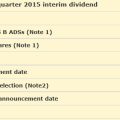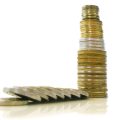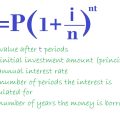How To Find The Best Dividend Stocks – 5 Key Things You Must Know
Investing in high dividend-paying stocks is a cool way to put your money to work. Why? Because it has many advantages over its alternatives like bond investing. If you are interested in all of the pros and cons of dividend investing, you can check our article on the matter here, in this post we are going to explain some key and very basic things one should know about dividend-paying stocks. If you are completely new in this field, you’d better check out our reading about the very basics of dividends. The current article is about the basic terms that characterize a dividend-paying stock – what exactly they mean and how to read them.
1 High And Low Dividend Yield
What is dividend yield? This is the percentage that determines the rate of return on your dividend investment (i.e. 7.45%). It’s calculated by the following formula:
Dividend Per Share / Share Price * 100 = Dividend Yield
For example, if the price of one share is $100 and the company pays a dividend of $6 per share, then the dividend yield of this stock is:
$6 / $100 * 100 = 0.06 * 100 = 6% dividend yield
Please note that if the share price falls, the dividend yields go up and vice versa. In our example, if the price of a share drops to $80 and the dividend remains the same ($6 per share), then the dividend yield becomes:
$6 / $80 * 100 = 0.075 * 100 = 7.5% dividend yield
When the price changes (this happens daily) – the dividend yield changes. Have this in mind when you read outdated dividend yield numbers because they are probably not true for the current price.
If a company has a very high dividend yield (low share price related to the dividend), this may mean that the market is expecting a dividend cut or that the company is facing some major risks ahead. Remember, there is no free lunch. Although it’s possible that the high yield is fully covered by the company’s profits, usually, the higher the dividend yield is, the more risky and unreliable the dividends are. This is why one should not consider only the yield but also other very important ratios as the payout ratio.
2 What Is Dividend Payout Ratio
The dividend payout ratio is simply how much of its profits a company is paying as dividends. For example, a company with a $10 million net profit for the last year that pays $1 million in dividends has a payout ratio of 10 %. You can calculate this by the following formula:
Payout ratio formulas
Dividends / Net Profit * 100 = Payout Ratio
In our example: 1 mil / 10 mil * 100 = 10% payout ratio.
or
Dividend Per Share / Earnings Per Share (EPS) * 100 = Payout Ratio
This ratio is very important. If a company has a payout ratio greater than 100%, this means that its profits are not enough to cover the dividend payments, the company pays more than it generates as a profit. As this may be possible for a company to do this for a couple of years (it may use piled-up cash or even borrowed money for the higher payment), in the long run this is totally not sustainable! Sooner or later such a company will either have to generate more profits to cover the dividend or will have to cut the dividend to reduce its payout ratio under 100%. Don’t get trapped by companies offering high dividend yields but that also have payout ratios of more than 100%. Always make sure that the promised dividends are well covered.
3 What Taxes Do I Pay For Dividends?
Another very important factor to consider when you are looking for high dividend-paying stocks is the taxation of dividends. In the most common case, all dividend payments are subject to taxation of course. But taxes can vary depending on your country’s laws and the company’s country laws. In some cases, you owe 0% dividend tax and in others, the tax can reach up to more than 45% of the dividend amount.
In the common case, the dividend tax in the USA is 15% for qualified dividends, as well as capital gains, for individuals in the 25%, 28%, 33%, and 35% income-tax brackets. People with more than $400,000 in taxable income and couples with more than $450,000 will see the rate rise to 20%. A qualified dividend is any dividend that is taxed at the capital gains tax rate. In the common case, most regular dividends from U.S. firms (corporations) are qualified. You can check this for more info: https://en.wikipedia.org/wiki/Dividend_tax
In the UK, you pay 0% tax up to a certain amount of dividends (dividend allowance) (5000 pounds in 2018, 2000 pounds in 2019…). The tax may rise as much as 38.1 %. Here are some more details:
| Tax band (UK) | Effective dividend tax rate (2019) |
|---|---|
| Basic rate (and non-taxpayers) | 7.5% |
| Higher rate | 32.5% |
| Additional rate | 38.1% |
| Additional rate – dividends paid before April 2013 | 36.11% |
If you are not sure what taxes you must pay, you’d better hire a professional for help. Please note, that the responsibility for declaring and paying your taxes is completely yours.
Also, have in mind that these things change when the law changes and this happens from time to time.
4 Important Dividend Dates
When a company pays dividends, 4 main dates are involved in this process: declaration date, date of record, ex-dividend date, payment date. To read more about them, follow the link above and read the detailed article about them. Here is what each of this dates means:
Declaration date – this is when the board of directors declares that the company is going to pay a dividend to its shareholders. It announces how much will be paid, the date of record, and when the payment will be made.
Date of record – this is the date before which you must be in the company’s shareholders’ book, in order to receive the dividend. This date is determined by the company and it is used to determine the most important date for a dividend-paying stock – the ex-dividend date. Please note, that this is not the date up to which you must buy shares to get the dividend. For example, if the date of record is 01.01.2015, this doesn’t mean that if you purchase shares a day before this date you will catch a dividend payment. This is because each stock purchase needs a few days to be settled, depending on the exchange it is traded. This is why you need the ex-dividend date
Ex-dividend date – the most important date – you get the dividend if you buy or own the shares before this date and you miss the dividend if you own or buy shares on or after this date. As simple as that. This is the first date the shares are traded without the current dividend payment. This means also that if you sell your shares on this date, you still catch the dividend.
Payment date – this is when the dividend payment is made to the shareholder, this is when you get your money.
5 When Are Dividends Paid?
The dividends are paid on the announced payment date. You can see more about the important dividend dates here. If you purchased your shares via a stockbroker and you have a brokerage account, you receive your dividend payment directly there. In other cases, the company chooses a bank responsible for dividend payments and you can claim your dividend in the bank’s office.
Dividend Investing In General
Dividend investing is a popular strategy used by investors to generate income and grow their wealth over time. It involves buying stocks that pay regular cash payments, called dividends, to their shareholders. Typically, dividend payments are paid quarterly, though some companies might pay dividends annually or monthly.
When selecting stocks or other vehicles for dividend investing, it’s important to consider factors such as risk tolerance, current economic conditions, the projected performance of the company and industry trends, and tax consequences. It may be beneficial to look for companies that not only have a history of consistently paying dividends but also ones with a history of increasing those dividends over time; this could provide potential long-term appreciation in addition to regular income payments.
Dividend investing isn’t right for everyone; those looking mainly for appreciation in the price of their stocks may not benefit from dividends as much as those who seek steady income streams through dividend payments. However, it can offer investors an opportunity to generate additional returns and reduce risk depending on their individual objectives.
Overall, dividend investing can be an effective strategy for generating good returns as well as growing your portfolio over time through both income earned and capital appreciation due to reinvesting dividends and compounding returns. As with any investment strategy though, it is always important for investors to perform their due diligence before getting started with any particular security or investment strategy.
Did you like this post? Please, share it and help us maintain this site! Thanks!





